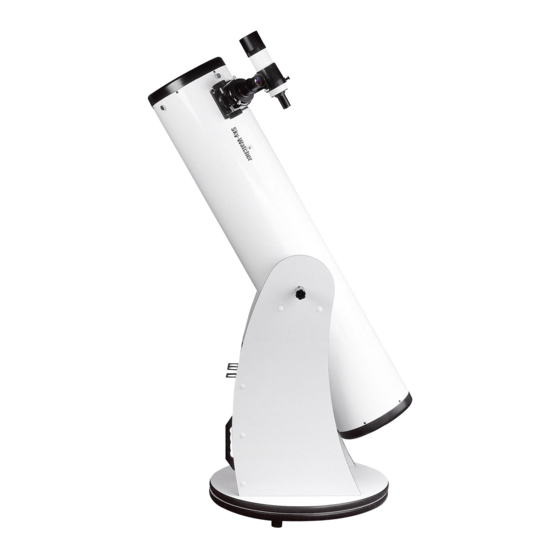
Table of Contents
Advertisement
Quick Links
Advertisement
Table of Contents

Summary of Contents for SKY-WATCHER DOB8
- Page 1 INSTRUCTION MANUAL DOBSONIANS 150mm/1200mm 200mm/1200mm 254mm/1200mm...
-
Page 2: Table Of Contents
TABLE OF CONTENTS Assembling Your Telescope Parts List Base Assembly Optical Tube Assembly Operating Your Telescope Aligning the Finderscope Focusing Using the optional Barlow Lens Using the Tension Control Handle Pointing the Dobsonian Calculating the Magni cation (power) Calculating the Field of View Calculating the Exit Pupil Observing the Sky Sky Conditions... -
Page 4: Base Assembly
ASE ASSEMBLY 1. Connect the board B to the 2. Connect the assembly 3. Attach the round plastic feet to board board A1 and A2. Make sure to the round board C. D. Place the teflon pad in between the logos on the board A1 the assembly from step 2 and the and A2 are on the outside. -
Page 5: Optical Tube Assembly
PTICAL TUBE ASSEMBLY 9. Place the optical tube between the board 10. Install the handles from package 7 A1 and A2. Make sure that the side bearings into the holes on the board A1 and of the tube are rested on the 4 cylindrical A2. -
Page 6: Operating Your Telescope
OPERATING YOUR TELESCOPE Fig.a These fixed magnification scopes mounted on the optical tube are very useful accessories. When they are correctly aligned with the telescope, objects can be quickly located and brought to the centre of the field. Alignment is best done outdoors in day light when it's easier to locate objects. -
Page 7: Using The Tension Control Handle
Fig.e tension control Loosen or tightend the tension control handle to add just enough friction to allow the tube to move easily when nudged but to stay in position when not. It may be necessary to re-adjust the tension control handle when accessories are added to, or removed from, the tube. -
Page 8: Calculating The Magni Cation (Power)
The magnification produced by a telescope is determined by the focal length of the eyepiece that is used with it. To determine a magnification for your telescope, divide its focal length by the focal length of the eyepieces you are going to use. For example, a 10mm focal length eyepiece will give 80X magnification with an 800mm focal length telescope. -
Page 9: Observing The Sky
OBSERVING THE SKY Sky conditions are usually defined by two atmospheric characteristics, seeing, or the steadiness of the air, and transparency, light scattering due to the amount of water vapour and particulate material in the air. When you observe the Moon and the planets, and they appear as though water is running over them, you probably have bad "seeing"... -
Page 10: Proper Care For Your Telescope
PROPER CARE FOR YOUR TELESCOPE Fig.g Collimation is the process of aligning the mirrors of your telescope so that they work in concert with each other to deliver properly focused light to your eyepiece. By observing out-of-focus star images, you can test whether your telescope's optics are aligned. -
Page 11: Cleaning Your Telescope
Aligning the Primary Mirror hex bolt inside Fig.l Locking screw There are 3 hex bolts and 3 Phillip's head screws at the back of your telescope, for 150mm/1200mm and 200mm/1200mm the hex bolts are the locking screws and the Phillip's-head screws are the Adjusting screw adjusting screws. - Page 12 NEVER USE YOUR TELESCOPE TO LOOK DIRECTLY AT THE SUN. PERMANENT EYE DAMAGE WILL RESULT. USE A PROPER SOLAR FILTER FOR VIEWING THE SUN. WHEN OBSERVING THE SUN, PLACE A DUST CAP OVER YOUR FINDERSCOPE TO PROTECT IT FROM EXPOSURE. NEVER USE AN EYEPIECE-TYPE SOLAR FILTER AND NEVER USE YOUR TELESCOPE TO PROJECT SUNLIGHT ONTO ANOTHER SURFACE, THE INTERNAL HEAT BUILD-UP WILL DAMAGE THE TELESCOPE OPTICAL ELEMENTS.
















Need help?
Do you have a question about the DOB8 and is the answer not in the manual?
Questions and answers